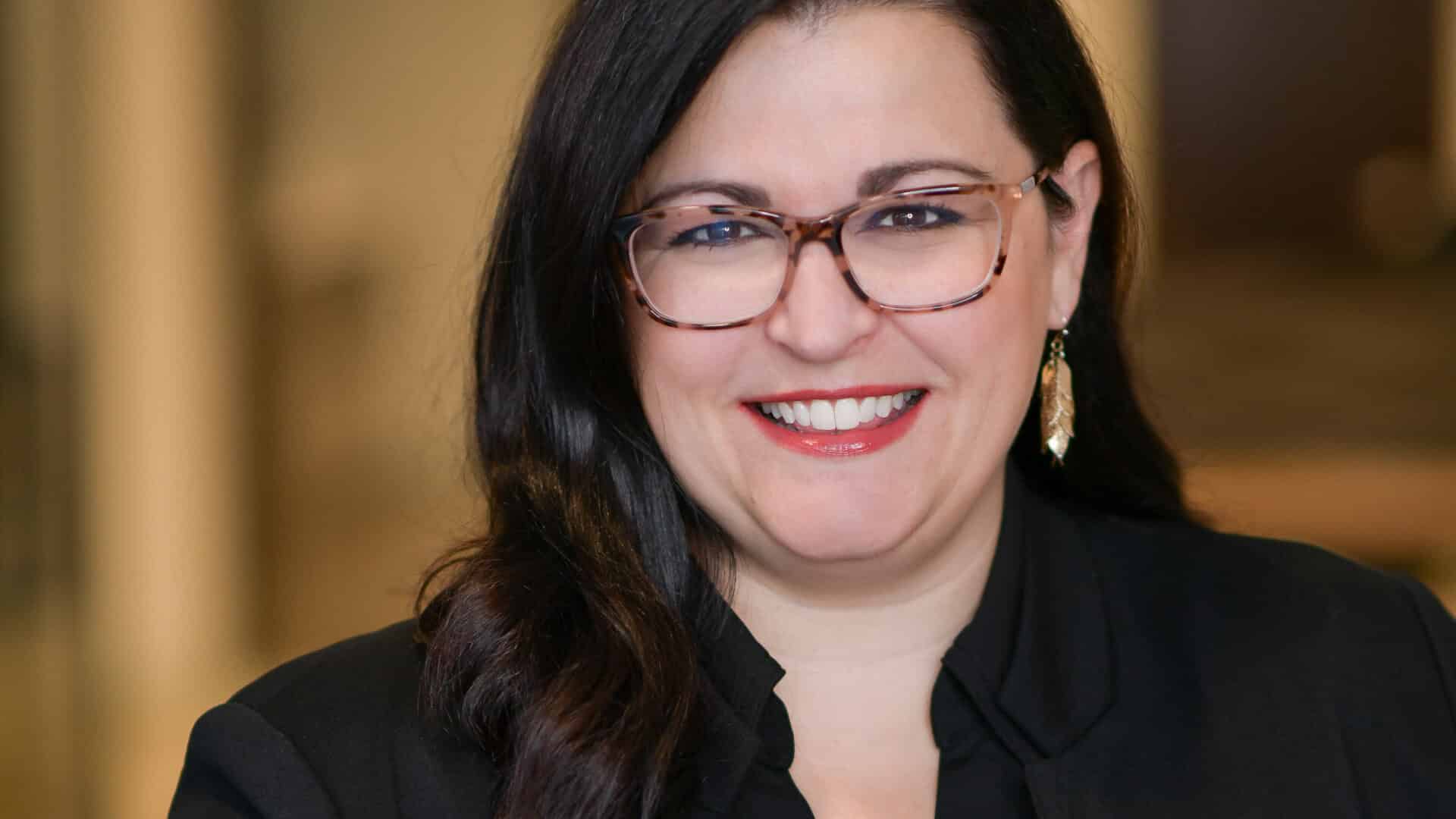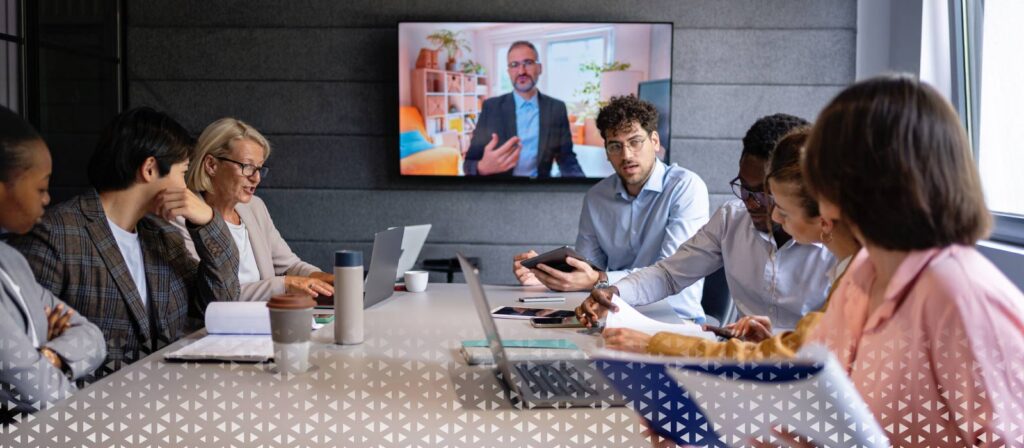Angie Earlywine is a leader in innovative workplace strategies, strategic facility planning, and workplace change management, with over 20 years of experience. Her current role is Senior Director in the Total Workplace division of Global Occupier Services at Cushman & Wakefield. She’s been on the frontline of helping organizations respond to both the pandemic and the subsequent return to the office. In this interview, Angie provides her expertise on the hybrid workplace experience and why authentic choice matters.
We sat down with Angie to learn how a choice-driven strategy can help fuel a better return to the office. She offered insights on a range of issues surrounding the hybrid workplace experience. She stresses that inspiring employees and offering them real flexibility and authentic choice is the key to having more engaged employees and better work-life balance, and therefore a better employee experience.
As a thought-leader on navigating post COVID-19 workplace re-entry strategies, Angie helps organizations use data to understand employee needs and improve their hybrid workplace experience.
In this interview, we chat about:
- How hybrid work is impacting employees on an individual basis
- Using a purpose-driven approach when planning the office
- The future of remote working
- Key indicators for measuring a successful return to the office
- The antidote to reducing financial risks associated with organizational change
- The ‘T’ word that is so important to any workplace strategy
- The problem with trying to give everyone a similar employee experience
- Technology, including desk booking and room bookings, to improve parity of experience
- How to avoid making knee jerk decisions for your real estate portfolio
- The real challenges remote workers are facing—and how to respond to them
- How a hybrid workplace experience strategy can help organizations survive the Great Resignation
- What authentic choice in a workplace really means
- Five critical emerging workplace trends to watch out for
After nearly two years, how is the hybrid workplace experience impacting the employee experience, both positively and negatively?
The positives and negatives can be varied down to the person. But ‘hybrid’ is probably an overused word, as we think about how to describe what we’re going through. At least 50% of most workforces we’re seeing want to be hybrid. But companies need to define what the hybrid work model means for them. Modeling how often employees will be in-office is the million dollar question impacting today’s real estate needs.
When it comes to employee experience now, we’re focused on redefining and reimagining the purpose of the office post-COVID. We know that purpose drives behavior. If we can truly capture the purpose of the office, we’re going to be much more likely to get it right.
There’s this question everyone faces when they wake up every morning: What’s the purpose of my workday?
If an employee is meeting with their colleagues, they might want to do that in person, in the office. But if they’re going to be doing focused work for the day, they might be more successful in their home office environment, where they can control their productivity better.
As we assess the negatives and positives of hybrid working to improve the hybrid workplace experience, we need to really understand the purpose of the office. The data shows us that people no longer want to go into the office to sit alone doing focused work. They can likely do that somewhere else. But they do go to the office purposefully for key team meetings, social events, and collaboration. These are the things we’ve all been craving in the past year or two.
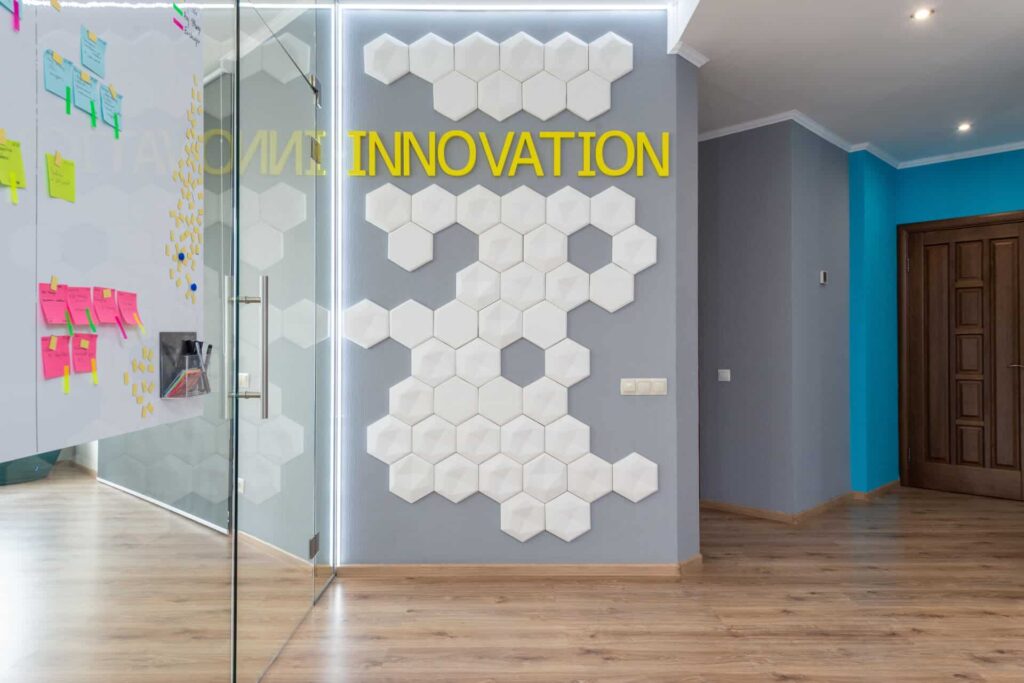
Companies have had time to adapt to hybrid and remote working, as well as to demands for health and safety. What examples are you seeing of getting the hybrid workplace experience right?
We’ve never been out of the office for this duration. Two years is a long time to get settled into new behaviors and we won’t change back overnight. At this stage of returning to the office, we have to acknowledge the importance of being flexible with our solutions. We must also acknowledge the importance of listening to employees and being willing to adapt as needs evolve.
Some of the key indicators we’re seeing from companies that are starting to return to the office are that companies that are embracing the ambiguity of the situation that seem to be faring better than those that are being more rigid.
You need to ask some really tough questions to get the return to the office right. In some cases, returning to office is not appropriate for some segments of the workforce. We’ve benefitted from the last two years of the greatest work from home experiment of all time. Organizations need to be willing to ask their people to share the pros and cons from their work experience during the pandemic. And they must be vulnerable enough to really listen to their responses as they redefine the future purpose of the office.
I also believe that offering the greatest amount of flexibility in where and how people work in the future will absolutely improve the overall work experience.
Our clients that are faring better are those ready to pivot when they hear feedback that something isn’t working. They’re listening, they’re reacting. And they’re being transparent saying to their teams, ‘we’re on this journey together, we’re going to pilot some ways of working, and we need your feedback in order to get this right.’
It’s best to conduct employee surveys and focus groups regularly to check in with everyone in real time. Then adjust based on that feedback. If I invest in technology or space, or if I reduce real estate because I don’t think we need as much, all of that is a potential risk with significant costs associated. The antidote to figuring out how to reduce risk is in ensuring you’re aligned with employee sentiment and the company’s vision for supporting a hybrid work environment.
Can there be such a thing as too much pivoting in the work environment? How does that affect employees?
Organizations are trying to set guide posts for how their program is going to look. Whether that’s free addressing, 100% working remotely, or a hybrid of both. They’re trying to say, ‘here are the parameters, and now work with your manager to align on the details for what will allow you to do your best work, support the needs of your team, and your personal preferences.’
When an employee says they’re in the office two days a week, managers may care about which days they choose to best support collaboration. If everyone shows up on the same days, facilities and real estate leaders have to plan for those surges in space accordingly. If someone is only coming into the office one or two days a week, they likely don’t warrant a dedicated space.
Or they might have special ergonomic requirements or special hardware and software that are only available at a given spot. This might pose an exception and a dedicated space might be best for that individual. This level of granularity can really only be determined between the manager and the employee.

Are we finally seeing a cultural shift in how remote work is viewed? Do organizations now trust employees to work from anywhere?
Yes! The big ‘T’ word—Trust—has to be the foundation for the workplace strategy.
The past two years have proven remote work can be successful for many workers. And we know productivity was at an all time high for most organizations.
So if there’s still an issue around trust, it’s usually rooted in the culture. Most people do the right thing. They enjoy the work that they’re doing. The labor market is too competitive now to not be doing what you love. Or to work for a company that you don’t believe in.
What can companies do better to ensure everyone has a similar employee experience, no matter where they’re working from? How can they improve the employee experience platform they offer?
Trying to provide a ‘similar’ employee experience is exactly the problem we’re seeing in the last year. Trying to be one-size-fits-all with ‘assuming’ could be risky. That approach didn’t work before the pandemic, and it certainly doesn’t work now. Workers benefit from a choice between being fully remote, hybrid, and fully in-office.
The desire for people to feel inspired is the single greatest indicator around how to improve employee experience. The holy grail of engagement is feeling inspired in what you’re doing and by the people you work with.
Employee experience is really the name of the game right now.
There’s purpose for the company, purpose for the team, and purpose for the individual. Staying authentic to your purpose is what can help ensure everyone has the right employee experience.
If you have not defined what a good employee experience is for all layers of the organization, you’re missing out on one of the most important drivers that impact a successful return to office..
As a specific example, if you’ve have a team that is autonomous, they’re all individual contributors, and they’re heads-down most of the day, then giving them access to a neighborhood at the office that’s has the swankiest collaboration space in the whole building does nothing to inspire them to do their best work.
Take an opposite group, like an innovation-based team that’s all about iteration, failing fast, and being highly collaborative. Give them that same collaboration space and it can be a game changer for the success of that team.
Those are two extreme examples, but they highlight that if it’s not fit for purpose, down to the team level and down to the individual, you could be misappropriating funds, resources, space, and technology.
Figuring out that recipe of what to give to each team and how that’s appropriated in the workplace is complex. One of the most important things we have to do as workplace strategists is figure out what is fit for purpose, down to the team and down to the individual and how does it align to the short and long term goals of the business.
What that brings about is this desire to have a workspace that’s truly flexible.
Provide the entrée of options, the buffet of workplace choices, and trust your people to go where their best work will be enabled. If you can provide that variety, throughout your floor and throughout your building, that’s where you really start to foster game-changing productivity and innovation.

What technologies are companies adopting to adapt to the pressures of the hybrid office and hybrid workplace experience?
There are four things that anyone thinking about workplace strategy and the future of work should be aware of:
1. Collaboration technology
The first one is the concept of collaboration technology. Parity of experience is huge for collaboration tech. It’s also a challenge given the changes in human behavior it requires. If you can leverage tech to see on a floor plan who’s in the office on a given day, you may choose to also come in and sit adjacent to each other if you are working on something that would benefit from in-person presence.
For meetings, you may have half the team virtual, and half the team in person. Typically the people in the room get more airtime and attention. We have to work harder now to equalize this experience. How do we make sure that the person who is remote feels as connected to the discussion as the person who’s sitting at the table? This raises new questions. Should we be using software to track who’s speaking to bring awareness to how inclusive a hybrid meeting is?
Workplace leaders really need to think through how they’re running hybrid meetings to ensure inclusivity. Maybe for certain meetings, everyone needs to come in that day, to equalize the experience for everyone. Or maybe everyone all goes virtual for the meeting, even the people who are in the office that day. We weren’t thinking about parity of experience two years ago. But we absolutely have to think about that now with a distributed workforce.
Note: OfficeSpace launched a Visual Directory that is available via mobile app and integrated with Microsoft Teams and Slack, also to help overcome the challenge of understanding the workplace and where colleagues are any given day.
2. Reservation systems
The second idea is around reservation systems, which are not just about giving the employee their place for the day. They’re also triggering the brain to think about where the best work is going to happen for the day. This isn’t something we normally think about. We used to come in every day to the spot that was assigned to us in an almost robotic way.
It’s so powerful for an employee to think about their day and be able to see available work setting options on an app and think, ‘well I could work here or here or here… But I’m in meetings all day, and I want to do my one-on-ones in private, so I’m going to book a shared office for the day.’
If we move to a free address system and provide all work setting choices and now there’s a reservation system in place that’s going to cue the brain to think about where the best work is going to happen today—that’s a beautiful thing to happen.
The other piece of reservation systems, is you can now see where your team is and be more strategic on your work seat for the day. Even if you have a dedicated neighborhood, you might want to choose to sit next to someone because you haven’t sat by her and she’s new to your team, and you’d love to mentor her for the day. Or if you’re working with someone on a deadline, you can sit side-by-side to hash through it.
So reservation technology has multifaceted benefits to help employees find new ways to be strategic—that’s what it’s all about. Instead of just showing up for the day, how are you going to be more targeted and strategic, to allow best work to flourish?
3. Sensor deployment
The third technology is sensor deployment, which is less about perks to the employee, at least initially. It’s more about using automation to understand occupancy trends. This, in turn, provides long term benefits to the employee. You can make really smart decisions around occupancy and how space is best used. For example, if sensors can tell you that that private phone room only had 2% utilization for the last three months, you might decide to repurpose it by converting it into a team space.
4. Data analytics
Finally, it’s when you start to aggregate these results, that you really start to tell the story, using data analytics to drive decision-making. Even though it’s been two years of remote work, we haven’t had long to truly test the hybrid workplace experience. So it still feels like a knee jerk reaction to just start reducing real estate without looking at the data and employee experience first. We’re telling our clients, ‘let’s pilot concepts, let’s capture how the workplace experience is impacted as we redefine the future of the office.’
Note: Workplace strategists can concurrently use a tool like scenario planning to experiment with proposed new strategies before investing in them on the ground.
Let’s look at how people are coming back and how that’s working. Let’s get feedback from the users of the space. Whether it’s from low-tech comment boxes in the café, or whether it’s pulse surveys taken on a monthly basis.
You’re looking at the tech data, you’re looking at the sensor data, you’re looking at the reservation system, you’re capturing employee feedback, and that’s all forming a story that can then drive decisions around the demand for real estate.
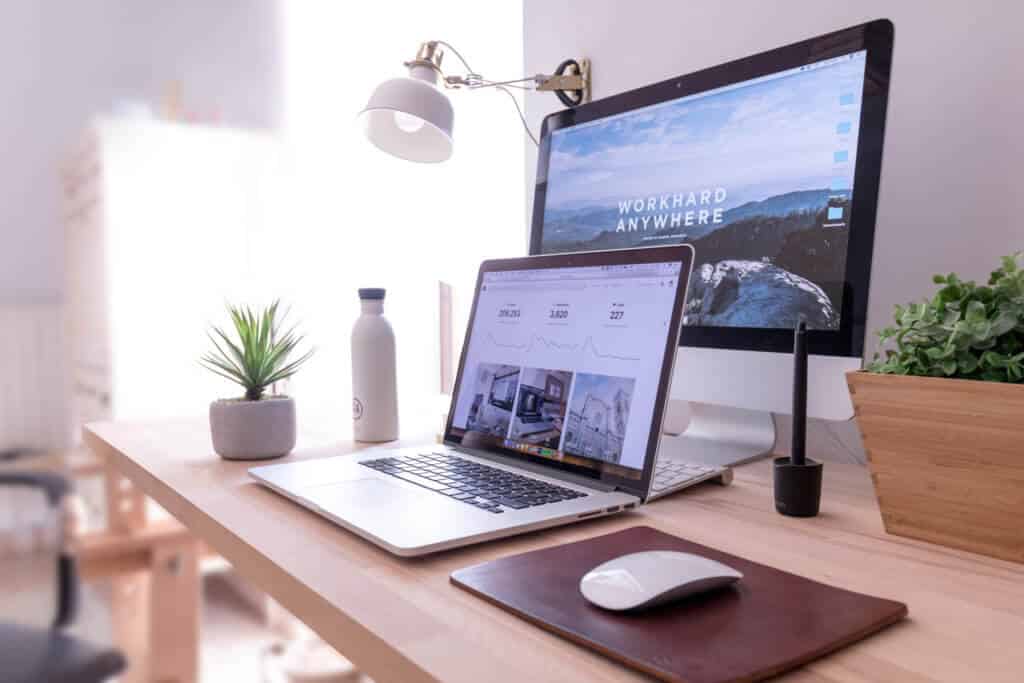
What are the biggest challenges that remote workers and managers of remote workers face?
Within Cushman and Wakefield, we have something called Experience per Square Foot™. It is a workplace experience survey tool that was developed pre-pandemic and continues to evolve. It’s one of the most profound surveys in the industry with 43,000+ global responses.
We know what the biggest challenges actually are for remote workers, because we asked them!
50% of remote workers said culture has suffered because they’ve been remote. There aren’t social events, and there’s not a lot of in-office activity currently. They’re not feeling connected to the company culture, especially those new to the organization.
55% are saying that employee well-being has suffered, too. Work and life have really blurred, and it’s difficult to not have a commute that separates work and home. We worked longer hours during the pandemic resulting in an unsustainable all time productivity high. As the world re-opens and there are more things to get back to besides work, we expect to see productivity continue to normalize.
56% are also feeling less connected to their colleagues. We can only connect so much over video, and so when you’re remote and not having in-person events that has some residual effect.
And 64% have reported that learning and mentoring have suffered. We’re not doing mass trainings right now, everything is pretty much virtual, and even mentoring at the coffee pot, in the hallway, sitting next to someone, overhearing a conversation with your colleagues—all of that has pretty much come to a halt.
We are seeing that at least 50% of remote workers are reporting that they want to work hybrid in the future and this varies by company. So we have to solve for how we deal with culture and learning and mentoring in the hybrid workplace experience. Perhaps as we think about the purpose and future of the office, it will be to solve for those very things.
In other words, how can the office environment be repurposed to be less about focused work and more about mentorship, social events, and collaboration?
We also know that hybrid workers struggle the most. And it’s because of the nuances of a back and forth lack of routine. I forgot my cable, I forgot that the café isn’t open and I didn’t bring my lunch today, and so on. Whereas when you’re doing the same thing everyday, you can get into a better routine.
Hybrid workers that figure out what their best routine is will be more successful. We know that workplace experience suffers when they are told a specific schedule to follow for in-office time vs. having the freedom and choice to select on their own. When you tell someone , ‘you have to be in the office Monday, Wednesday, and Friday.’ Those might be the worst days for that particular worker for personal or professional reasons. Going back to trust as a key core value, we have to trust and empower our people to make the right decision. And they will rise to the occasion.
Instead, when a worker has the choice to pick which days are best given the workload she has for the week, and given what’s going with the rest of her life, that is where employee experience scores start to go up.
On the experience scores, the overall experience score is only 45% if you don’t give them a choice. For example, if a manager tells them what days they have to come in. But if you give workers complete choice and freedom, that score jumps to 74%. That’s a significant finding that shouldn’t be ignored.
Business leaders need to acknowledge how critical this data is. It doesn’t mean you have to be 100% choice-driven all the time. A manager should absolutely be able to pull their team together when something important is happening or there’s an issue. I’m talking about everyday situations, not the extreme outlying examples when choice is at play.
And when you let your team have choice, they need to communicate those choices. Together, you can figure out what kind of space is going to be required. Not only in the short term but in the long term as well. Determining the number and types of work settings and the impact the new building occupancy has on things like conference room demand, amenities, and food service is complicated, but that’s the job of the workplace strategist to build the right recipe of ingredients to serve up the right employee experience.

How can you tell if your work from home policy is working? What can you do if it’s not working?
Company culture trumps workplace strategy any day. We know any work from home policy should be closely aligned with not only company culture, but its core values and mission.
If you lead from a trust-first perspective, people will do the right thing.
And if you manage to the worst denominator, I think we all know what’s going to happen with that team in this era of the Great Resignation.
You want managers for your hybrid workforce to have empathy and a trust-first mentality. Employee stress levels go down when workers don’t worry about always having the green light on in Teams. Work is still happening. We know that from that data. Companies still were successful all through the pandemic, and it’s because people were attending to their work.
I really hope we are past the days of ‘I don’t trust that my people are working because I can’t see them.’
But if things aren’t working seamlessly, you need a systematic method for pulse checks. There are best practices and nuances to managing a mixed remote and hybrid team. And there are benefits to having regular training programs. Don’t assume managers don’t need training and that employees know how to not just survive, but thrive in this new model.
There’s a very different dynamic to managing remote workers because you have this issue of parity, which was already an issue in the workplace. When I think of diversity, equity, and inclusion, parity of experience is important to all these things. If you’re that one person who’s always remote, are you going miss a promotion because your manager hasn’t found a way to engage you in the team discussions?
You need to be able to evaluate feedback from your pulse checks, make sure that you understand the ideal state for your team, and acknowledge that what worked for your team on month one of your return to office journey may differ six months down the road. It’s okay if your approach to what works best for your team changes over time.
We know that 78% of people are expecting that work from home policies will be expanded and codified to help them balance home, office, and their lives. Basically, they want some assurance. People are more likely to leave an organization that is not clear about providing flexibility in writing, than a company that publicly commits to a formal flexible work arrangement. It’s just not enough to verbally say ‘we’re flexible.’ We’re a “show me the receipts” dominated generation so it has to be in writing.
How is the Great Resignation impacting how companies think about their physical office space? How can workplace strategy affect employee retention?
Recruiting, attraction, retention—people issues continue to be the single greatest challenge, now exacerbated by the pandemic and the resulting labor challenges.
We can look at the data and say that resignations diffuse when you start increasing choice and flexibility. If you tell someone they can work remotely, even from a different state, that now allows the company to have the talent that they need, while the employee has the flexibility they want and arguably deserve
The Great Resignation also diffuses when you provide flexibility in hours. So do workers really have to be online from 9-5? Or can flexible work not just be about where you work in terms of location, but also in the hours you work? For example, can you change your core work hours to help people avoid peak rush hour commute times? Some companies are instituting core collaboration hours at certain times during the week based on what works best for the team. This allows for focused work to occur on the off-collaboration hours.
Remember: that experience scores jump from 45% to 74% if you give your employees choice and flexibility.
Knowledge workers especially should have some flexibility on how they can craft the most efficient work day possible.
What are the biggest challenges for physical workspaces post-COVID?
The case for sustainability and wellness really dovetails nicely with what we’ve learned during the pandemic. There’s nothing like a virus to make us much more aware of what we’re breathing, touching, etc.
The challenge is that some of the COVID-proofing workplace improvements are not visible to employees. You can’t look at a counter and tell that it’s an antimicrobial surface. Unless you tell employees, ‘we’ve switched out all of our filtration’ and ‘we now have antimicrobial surfaces,’ they won’t know. You won’t get due credit for making these changes to benefit your employees unless you have a communication campaign.
People need messaging when you make improvements. Be open and talk about what improvements you’ve made to the work environment. Oftentimes, cleaning crews come in like Batman in the dark of night after hours. But now, we don’t mind seeing them. We almost want to see those physical reminders that our personal well-being is important.
Also, when planning to return to the office, don’t be aggressive in putting everyone right next to each other. Have options for people to spread out. When they feel comfortable convening, they will do so at their own pace. Take a few chairs out of conference rooms and give each other some space. We are all going to bring a certain level of anxiety with us for a little while around personal space. We don’t yet know for how long that’s going to last. So densifying a conference room or cramming people into a training room is probably not going to be the social norm for a while. Remember we all spent two years social distancing, that doesn’t change overnight.
When you think about returning to office and what drives human behavior, remember Maslow’s hierarchy of needs. The most basic needs are all about safety and security. It doesn’t matter that you added a new café with the best food service, if someone doesn’t feel safe or secure, it’s a non-starter.
That’s why some organizations are having the return to office focus be on a voluntary basis in the initial re-opening phases.
You may have a contingent of your workforce that may not have the right environment at home or strongly prefer to be in the office for personal preference reasons. Some people are itching at the chance to get back to normal. There may be others that have learned they can be more successful working remotely; they don’t have that same drive to return to office. You can’t assume either scenario. You have to do your homework and capture employee sentiment and ask the tough questions of your people if you want to create a people-centric approach to the workplace of the future.
Note: A tool like Distancing Planner can also make it much easier to simplify distanced seating plans and know how many seats you can safely offer employees in your space.
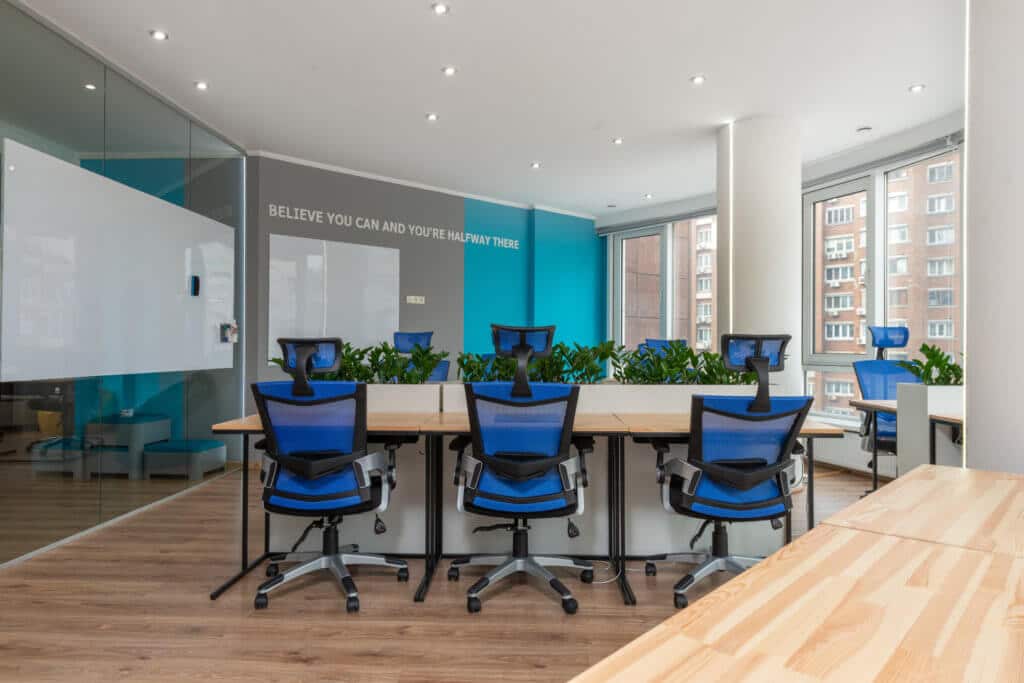
Are there any overarching best practices for supporting all workers and providing more flexibility in the return to the office?
There are a few big questions that really deserve our attention now:
How do we work?
The first question is around how we work. What is the range of activities for the team and for the individual? When you understand that range of activities, you can really start to understand where best work can happen and can plan work settings accordingly.
Where do we work?
The second piece is around where we work. When is it important to be virtual, and when is it important to be in person? That gets back to that purpose of the office, and being purpose driven in everything that we do.
How does this affect the space we need?
And then the third piece is how does this all affect the space we need? And I don’t just mean in the office. If you’re going to pick 100% remote, someone should be paying attention to making sure your employees have the right monitor setup, the right ergonomic keyboard, the right task chair, and the right virtual environment (or digital workspace).
This also makes us think about not just the space we need, but the role of the workplace. So if we had to think about a journey map, what does the experience look like for an employee that’s in the office one day a week, versus five days a week? Their needs are different and therefore so are their expectations for a positive experience.
If you’re only in the office one day a week, then things like figuring out printing and booking a conference room might be important to you. But if you’re going to be there every day, you care more about things like the food service and the amenities, because you’re there all the time.
The journey map for each type of employee will be different. You need to be mindful of what that looks like, to help make sure that your best practice is relative to their experience.
Are you ultimately optimistic about the return to the office and how the hybrid workplace experience will evolve?
I think there is a light that we’re starting to see, glimmering at the end of the tunnel. Many have started to move forward with measured caution on return to office plans. But also while considering we’ve learned so much. Two years is a very long time to test things. We already know what made people tick when they were in the office. Now we know what makes them tick when they’re remote. Lets blend the best of both worlds as we proceed forward. Let’s consider the workplace as an entire ecosystem that supports best work practices.

What emerging workplace strategy trends are you most excited about?
At Cushman & Wakefield, we focus a lot on the concept of the workplace as an ecosystem. It broadens the definition of where and how work happens best. And it acknowledges that work is not a binary choice of either home or office. It can be both. It also calls attention to a renewed focus on the employee experience as a primary driver for enabling choice and flexibility in the workplace.
We are moving from a time of great uncertainty into confidence that conditions are improving. I think this is what will move us off of Mazlow’s bottom layer.
We already talked about how inspiring people is the single top driver for employee engagement. It’s important to reflect on how inspired people will feel at the workspace. Think about your workplace: Does it inspire ideas and collaboration and happiness and togetherness in social spaces? Or would you say, not so much? If you had to give your workplace a grade, what would it be? If it’s not helping you attract and retain talent, it’s working against you.
Much has changed in the past two years. We would be remiss to not leverage change management best practices to support a successful return to office, as we test new ways of working, and adapt to new technologies. Change leader teams can be your voice of the employee and help identify how people are adapting to the new normal and where they are struggling most as well as what they are most inspired by.
The closer you stay connected to the sentiment of your people as your barometer, the greater success you’re going to have, including getting the next gen of the workplace of the future right.
And the last thing to keep in mind about the hybrid workplace experience, is that authentic choice matters. Give people complete trust and choice to go where their work takes them.
OfficeSpace offers workplace management software that adds authentic choice to the hybrid workplace experience. Reach out for a free demo.
Photos: Angie Earlywine, Max Vakhtbovych, Vlada Karpovich, Marvin Meyer, Domenico Loia, BRUNO EMMANUELLE, Max Vakhtbovych, fauxels

